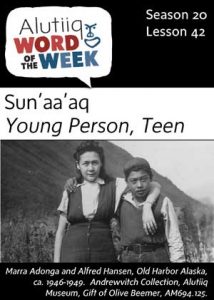 Sun’aa’aq–Young Person, Teen
Sun’aa’aq–Young Person, Teen
Sun’aa’rausqak Nuniami et’aarllriik.–These two, young people were in Old Harbor.
All human societies recognize the teenage years as a time of transition, a period when young people grow from children into adults. Adolescence is also universally a period of preparation, where boys and girls are trained for marriage, child rearing, and work. Alutiiq families educated young people through mentorship. Teens worked alongside family members to acquire the array of knowledge and skills needed for adult life. When sun’aa’aq were physically and socially mature, communities marked their new status in special ways.
For girls, menarche, the onset of menstruation, signaled adulthood. This was an extremely powerful moment, the point when a girl gained the power to create life. After a feast for family members and friends, the initiate gave away her toys and changed her appearance. She received a woman’s haircut, tattoos to her joints, and pieces of braided sinew tied around her neck, elbows, wrists, knees, and ankles. Finally, she put on an undecorated coat of reindeer calf skins and entered a period of seclusion in a special hut. The unusual coat symbolized her transformational state. At end of her confinement she took a steam bath and reentered the community. Alutiiq shaman, the intercessors of the spirit world, acknowledged the great power of this transition by decorating their clothing with the hair of young women preparing for seclusion.[xyz-ihs snippet=”Adsense-responsive”]For boys, first-kill ceremonies were the equivalent of a girl’s menarche ritual. Among the Chugach Alutiiq, boys gave away the meat from their first kill and then fasted for three days. This was followed by a feast where the boy was dressed as baby. Then, his mother sang him a lullaby, while another woman danced as the animal killed by the young man. A third woman pretended to kill the animal and distribute its fur, demonstrating the importance of the young man’s generosity.
Source: Alutiiq Museum





